Work-Energy Relationships - Complete Toolkit
Objectives
- To describe the conditions that determine whether the total mechanical energy of a system will be conserved or change; to use such conditions to predict if a given situation will involve energy transfer or energy conservation.
- To relate the amount of work that is done by non-conservative forces to the energy change of a system; and to make predictions about the final amount of kinetic or potential energy of such a system.
- To analyze a situation in which energy is conserved in order to predict the final amount of kinetic or potential energy.
- To use energy as a book-keeping tool in order to predict how far an object will move, how high an object will be, and how fast an object will be moving.
- To create a work-energy bar chart to conceptually describe the changes in the form and the amount of energy possessed by an object.
Readings from The Physics Classroom Tutorial
Interactive Simulations
- Roller Coaster Model
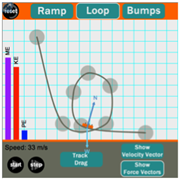 A roller coaster provides a wonderful example of energy conservation and transformation. This HTML5 simulation from The Physics Interactives section of The Physics Classroom allows students to investigate the various forms of energy for a roller coaster car traversing the track. Ramps, loops and small hills can be investigated. The velocity vector and the gravity and normal force vector can be toggled on and off. Small hot spots on each design can be dragged to modify the shape of the track. Friction can be added or removed. Energy bar charts display the amount of potential, kinetic and total mechanical energy in real time. A background grid allows one to make height measurements and the speed of the car is displayed during the animation. An activity sheet is provided to guide students through a lesson. The Interactive is compatible with iPads and Chromebooks and a perfect tool for a 1:1 classroom.
A roller coaster provides a wonderful example of energy conservation and transformation. This HTML5 simulation from The Physics Interactives section of The Physics Classroom allows students to investigate the various forms of energy for a roller coaster car traversing the track. Ramps, loops and small hills can be investigated. The velocity vector and the gravity and normal force vector can be toggled on and off. Small hot spots on each design can be dragged to modify the shape of the track. Friction can be added or removed. Energy bar charts display the amount of potential, kinetic and total mechanical energy in real time. A background grid allows one to make height measurements and the speed of the car is displayed during the animation. An activity sheet is provided to guide students through a lesson. The Interactive is compatible with iPads and Chromebooks and a perfect tool for a 1:1 classroom.
- PhET Energy Skate Park
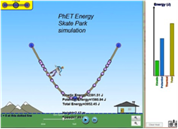 Explore conservation of energy by building ramps, jumps, and tracks for a skateboarder. The relationship of kinetic and potential energy to total energy is very clearly illustrated in this robust simulation from PhET. View energy bar charts and graphs of Energy vs. Time and Energy vs. Position. For extra fun, transport your skater to different planets and see the effects of changing the gravitational constant.
Explore conservation of energy by building ramps, jumps, and tracks for a skateboarder. The relationship of kinetic and potential energy to total energy is very clearly illustrated in this robust simulation from PhET. View energy bar charts and graphs of Energy vs. Time and Energy vs. Position. For extra fun, transport your skater to different planets and see the effects of changing the gravitational constant.
Teachers: Don’t miss this outstanding set of 35 “clicker” questions (with answer key), developed by PhET teacher-contributor Trish Loeblein. Download it as a pdf file or as a Power Point that enables you to customize the lesson. Multiple screenshots and illustrations help students visualize changing kinetic/potential energy levels in a variety of situations, as well as the influence of friction. NOTE: Choose the Power Point format to see the answer key. Link: Clicker Questions: PhET Energy Skate Park
NGSS and PhET: Energy Skate Park Lesson Design
This comprehensive resource was created in 2014 by a PhET teacher Workgroup to correlate the simulation “Energy Skate Park” with specific NGSS standards, performance expectations, and scientific/engineering practices. It refines the lesson focus so that particular NGSS DCIs (Disciplinary Core Ideas) are addressed and provides assessment evidence detailing how the activity meets goals.
Link: http://phet-downloads.colorado.edu/files/activities/3990/HSEnergySkateParkLessonDesign.pdf
- Stopping Distance
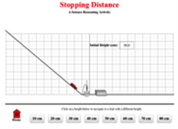 Work must be done to stop an object with kinetic energy. Put another way, an object with some amount of speed will require some amount of distance in order to be brought to a stop. In this Interactive, students explore the relationship between the initial speed of a Hot Wheels car and the distance over which work is done upon it in order to stop it. The motion is simulated, data is collected, and reasoning skills are used to determine the relationship between the stopping distance and the original speed. An activity sheet is available to facilitate students' exploration. The simulation is an HTML5 file and works great on tablets such as the iPad and on Chromebooks.
Work must be done to stop an object with kinetic energy. Put another way, an object with some amount of speed will require some amount of distance in order to be brought to a stop. In this Interactive, students explore the relationship between the initial speed of a Hot Wheels car and the distance over which work is done upon it in order to stop it. The motion is simulated, data is collected, and reasoning skills are used to determine the relationship between the stopping distance and the original speed. An activity sheet is available to facilitate students' exploration. The simulation is an HTML5 file and works great on tablets such as the iPad and on Chromebooks.
- Mass on a Spring
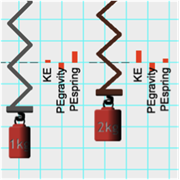 This HTML5 simulation from The Physics Interactives allows students to explore the conservation of energy for a vibrating mass on a spring. Varying masses can be lifted and placed on one of two springs and set into vibrational motion. The gravitational potential, elastic potential, and kinetic energies are displayed on a bar chart as the animation progresses. Plots of position and velocity as a function of time are displayed. A slider on a graph can be used to rewind the animation and view values at any given instant in time. Sliders also allow a student to alter the spring constant and the amount of damping in each spring.
This HTML5 simulation from The Physics Interactives allows students to explore the conservation of energy for a vibrating mass on a spring. Varying masses can be lifted and placed on one of two springs and set into vibrational motion. The gravitational potential, elastic potential, and kinetic energies are displayed on a bar chart as the animation progresses. Plots of position and velocity as a function of time are displayed. A slider on a graph can be used to rewind the animation and view values at any given instant in time. Sliders also allow a student to alter the spring constant and the amount of damping in each spring.
- Bungee Jumping Mode
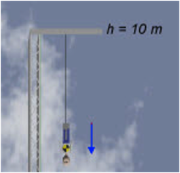 In this Easy Java Simulation (Ejs), a bungee jumper is dropped from a tower with a fixed length of bungee cord. As the jump happens, watch the changing bar graphs of kinetic energy, elastic potential energy, and gravitational potential energy. You can change the tower height, stiffness and length of the bungee cord, and the jumper’s mass. You can also display force vectors and view a graph of the g-forces vs. time. Don’t forget to allow for the jumper’s height when calculating an appropriate platform-to-ground distance!
In this Easy Java Simulation (Ejs), a bungee jumper is dropped from a tower with a fixed length of bungee cord. As the jump happens, watch the changing bar graphs of kinetic energy, elastic potential energy, and gravitational potential energy. You can change the tower height, stiffness and length of the bungee cord, and the jumper’s mass. You can also display force vectors and view a graph of the g-forces vs. time. Don’t forget to allow for the jumper’s height when calculating an appropriate platform-to-ground distance!
- PhET Pendulum Lab
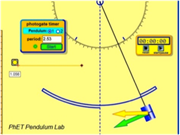 We like this Flash simulation for analyzing energy transformation and conservation of mechanical energy. You can watch the pendulum swing as an ideal system or add friction and see it gradually slow down. Change the mass and length and watch the results. Jump to Jupiter or the Moon to see how a pendulum swings in different gravitational situations. We especially like the Photogate timer that lets students quickly, accurately find the period of the pendulum. Very robust model.
We like this Flash simulation for analyzing energy transformation and conservation of mechanical energy. You can watch the pendulum swing as an ideal system or add friction and see it gradually slow down. Change the mass and length and watch the results. Jump to Jupiter or the Moon to see how a pendulum swings in different gravitational situations. We especially like the Photogate timer that lets students quickly, accurately find the period of the pendulum. Very robust model.
- Chart That Motion
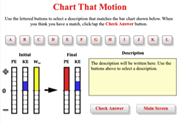 This unique HTML5 Interactive from The Physics Classroom provides students with 12 descriptions of physical situations. Each situation must be analyzed and matched to the corresponding work-energy bar chart. Immediate feedback is provided and student progress is tracked on the main frame of the simulation. This skill-building activity is a perfect tool for the 1:1 classroom. Works well on iPads, Chromebooks and mobile devices.
This unique HTML5 Interactive from The Physics Classroom provides students with 12 descriptions of physical situations. Each situation must be analyzed and matched to the corresponding work-energy bar chart. Immediate feedback is provided and student progress is tracked on the main frame of the simulation. This skill-building activity is a perfect tool for the 1:1 classroom. Works well on iPads, Chromebooks and mobile devices.
Video and Animations
- Veritasium: Bullet Block Experiment
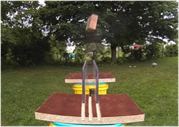 Take the Bullet Block Challenge! Physicist Derek Muller has another great discrepant event up his sleeve. A bullet is fired into the precise center of a block of wood and its motion recorded with high-speed photography. Now the block is moved so a second bullet strikes the right corner of the wood block. Will the second impact cause the block to go A) higher, b) same height, or c) lower than the first block? 79% of the people polled got the wrong answer. The correct answer involves concepts of energy and momentum.
Take the Bullet Block Challenge! Physicist Derek Muller has another great discrepant event up his sleeve. A bullet is fired into the precise center of a block of wood and its motion recorded with high-speed photography. Now the block is moved so a second bullet strikes the right corner of the wood block. Will the second impact cause the block to go A) higher, b) same height, or c) lower than the first block? 79% of the people polled got the wrong answer. The correct answer involves concepts of energy and momentum.
After watching the experiment, click here to see the results in slo-mo: Bullet Block Experimental Results
Finally, click here to see Dr. Muller’s explanation of what’s going on:
Explanation of Bullet Block Experiment
- Physlet Physics: Explorations in Energy Conservation
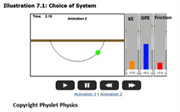 Here’s another great set of 24 concept-building animations from Physlets. We especially like this collection because it explores energy in the context of systems, then offers a variety of common physical systems to model representations of energy. Animated systems include a block on an incline, elastic collision, a ball in a frictionless bowl, a box sliding down a rough ramp vs. a frictionless ramp, an Atwood’s machine, a spring gun, an explosive collision, and more. Don’t miss Exploration 7.7 – an exploration of potential energy functions.
Here’s another great set of 24 concept-building animations from Physlets. We especially like this collection because it explores energy in the context of systems, then offers a variety of common physical systems to model representations of energy. Animated systems include a block on an incline, elastic collision, a ball in a frictionless bowl, a box sliding down a rough ramp vs. a frictionless ramp, an Atwood’s machine, a spring gun, an explosive collision, and more. Don’t miss Exploration 7.7 – an exploration of potential energy functions.
- Direct Measurement Video: Energy Conservation - Pendulum

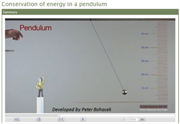 Direct Measurement videos are short, very high-quality videos of real physical events developed as an alternative to paper-and-pencil problems. Instead of a verbal description or drawing, students view a video clip that contains explicit data to solve a question. You can view the motion frame-by-frame to make precise measurements of quantities such as position and time, then use this data to apply physics concepts. In this video, learners can measure height of the pendulum above equilibrium and calculate pendulum speed as it passes equilibrium. From this data, they can compare mechanical energy at various points during the motion. Available as an HTML5 Player.
Direct Measurement videos are short, very high-quality videos of real physical events developed as an alternative to paper-and-pencil problems. Instead of a verbal description or drawing, students view a video clip that contains explicit data to solve a question. You can view the motion frame-by-frame to make precise measurements of quantities such as position and time, then use this data to apply physics concepts. In this video, learners can measure height of the pendulum above equilibrium and calculate pendulum speed as it passes equilibrium. From this data, they can compare mechanical energy at various points during the motion. Available as an HTML5 Player.
For tips on how to integrate direct measurement video clips in the classroom, click here:
How To Teach with Direct Measurement Videos
- Direct Measurement Video: Spring-Shot Cart

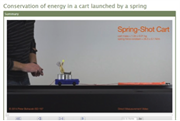 Direct Measurement videos are short, very high-quality videos of real physical events developed as an alternative to paper-and-pencil problems. Instead of a verbal description or drawing, students view a video clip that contains explicit data to solve a question. You can view the motion frame-by-frame to make precise measurements of quantities such as position and time, then use this data to apply physics concepts.
Direct Measurement videos are short, very high-quality videos of real physical events developed as an alternative to paper-and-pencil problems. Instead of a verbal description or drawing, students view a video clip that contains explicit data to solve a question. You can view the motion frame-by-frame to make precise measurements of quantities such as position and time, then use this data to apply physics concepts.
In this video, a cart is launched by a spring. You can measure the stretch of the spring at launch, plus the distance & time for the rolling cart after the spring has slackened. How much kinetic energy does the cart have after the spring is no longer stretched?
- PBS Learning Media: Inside a Solar Cell Interactive Animation
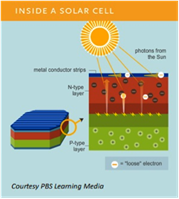 This is a very nicely sequenced interactive adapted from NOVA. It shows how a photovoltaic cell converts solar energy into electricity, providing a close-up look at each layer of the basic solar panel. It gives particular emphasis to how electrons cross over the junction that joins the two silicon layers in the cell. When the concentration of negative and positive charge between the layers reaches equilibrium, an electric field is produced – the solar cell is ready to capture photons.
This is a very nicely sequenced interactive adapted from NOVA. It shows how a photovoltaic cell converts solar energy into electricity, providing a close-up look at each layer of the basic solar panel. It gives particular emphasis to how electrons cross over the junction that joins the two silicon layers in the cell. When the concentration of negative and positive charge between the layers reaches equilibrium, an electric field is produced – the solar cell is ready to capture photons.
Teachers: Even if you typically don’t cover electrical energy in your unit on energy conservation, you might be interested in this resource because is specifically meets an NGSS Disciplinary Core Idea within the topic of Energy – Grades 9-12. The alignment is DCI HS.PS3.Dii – “Solar cells are human-made devices that likewise capture the sun’s energy and produce electrical energy.”
Labs and Investigations
- The Physics Classroom, The Laboratory, Work and Kinetic Energy
Student use a low-friction cart, a force probe and motion detector to explore the relationship between the work done on a cart and its kinetic energy change.
- The Physics Classroom, The Laboratory, Energy on an Incline Lab
Students push a cart up and inclined plane and use a motion detector to determine its kinetic, potential, and total mechanical energy at five positions along the plane.
- The Physics Classroom, The Laboratory, Energy of a Pendulum Lab
Students explore the conservation of mechanical energy for a pendulum bob vibrating to and fro.
- The Physics Classroom, The Laboratory, Spring Energy Lab
Students explore the conservation of mechanical energy for a vibrating mass on a spring.
- The Physics Classroom, The Laboratory, Stopping Distance Lab
Students use a Hot Wheels Car, a photogate, and a small box to investigate how the initial speed affects the stopping distance of the car-box system.
Link: http://www.physicsclassroom.com/lab/index.html#energy
Interactive Digital Homework Problems
- Mass on a Vertical Spring Digital Homework Problem
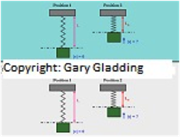 A mass hangs from a vertical spring. If the spring is stretched and then released, what is the speed of the block when it returns to its original position for the first time? Students will use the Conservation of Mechanical Energy method to solve the problem. The author anticipates conceptual roadblocks and helps students recognize when and how to use energy conservation principles when kinematic equations would be overly tedious. (Part of a large collection of research-based interactive physics problems from the University of Illinois)
A mass hangs from a vertical spring. If the spring is stretched and then released, what is the speed of the block when it returns to its original position for the first time? Students will use the Conservation of Mechanical Energy method to solve the problem. The author anticipates conceptual roadblocks and helps students recognize when and how to use energy conservation principles when kinematic equations would be overly tedious. (Part of a large collection of research-based interactive physics problems from the University of Illinois)
- David Maloney’s Physics Examples: Friction on a Skier
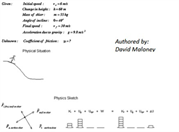 This annotated homework problem asks students to figure out the coefficient of friction between the skis and the snow for a skier on a downhill run. It’s different from the Illinois PER Interactive Examples in that the author provides the solutions alongside the sequential explanations of steps in the problem-solving. This resource is intended to supplement classroom instruction while allowing students to work at an individualized pace. It could be a great way to provide scaffolding for introducing friction into your unit on conservation of energy.
This annotated homework problem asks students to figure out the coefficient of friction between the skis and the snow for a skier on a downhill run. It’s different from the Illinois PER Interactive Examples in that the author provides the solutions alongside the sequential explanations of steps in the problem-solving. This resource is intended to supplement classroom instruction while allowing students to work at an individualized pace. It could be a great way to provide scaffolding for introducing friction into your unit on conservation of energy.
- Illinois PER Interactive Examples: Block and Spring Digital Homework Problem
 Another excellent interactive homework problem from physics education researcher Gary Gladding! In this problem, a 5 kg block slides down a frictionless ramp and compresses a spring. Given the spring constant and angle of the ramp, what is the maximum compression of the spring? This problem gives explicit guidance to help beginners understand the meaning of conservative force. Specifically, if there is no work done by a conservative force, then mechanical energy is conserved. This is good for students to comprehend because when dealing with conservative forces, they can use the Work-Energy Theorem to simplify their calculations.
Another excellent interactive homework problem from physics education researcher Gary Gladding! In this problem, a 5 kg block slides down a frictionless ramp and compresses a spring. Given the spring constant and angle of the ramp, what is the maximum compression of the spring? This problem gives explicit guidance to help beginners understand the meaning of conservative force. Specifically, if there is no work done by a conservative force, then mechanical energy is conserved. This is good for students to comprehend because when dealing with conservative forces, they can use the Work-Energy Theorem to simplify their calculations.
Minds On Physics Internet Modules:
The Minds On Physics Internet Modules are a collection of interactive questioning modules that target a student’s conceptual understanding. Each question is accompanied by detailed help that addresses the various components of the question.
- Work and Energy module, Ass’t WE5 - Conservative and Non-conservative Forces
- Work and Energy module, Ass’t WE6 - Work-Energy Bar Chart Analysis
- Work and Energy module, Ass’t WE7 - Energy Conservation
- Work and Energy module, Ass’t WE8 - Energy Conservation – Math Analysis
- Work and Energy module, Ass’t WE9 - Work and Energy Conversions
- Work and Energy module, Ass’t WE10 - Work and Energy Conv’ns – Math Analysis
Concept Building Exercises:
- The Curriculum Corner, Work, Energy and Power, Work-Energy Relationships
- The Curriculum Corner, Work, Energy and Power, Work-Energy Bar Charts
- The Curriculum Corner, Work, Energy and Power, Energy Concepts
- The Curriculum Corner, Work, Energy and Power, Work-Energy Calculations
Link: http://www.physicsclassroom.com/curriculum/energy
Problem-Solving Exercises:
- The Calculator Pad, Energy, and Power, Problems #15 - #32
Science Reasoning Activities:
- The Science Reasoning Center – Energy - Energy on an Inclined Plane
- The Science Reasoning Center – Energy - Hot Wheels Stopping Distance
- The Science Reasoning Center – Energy - Bat-Ball Collision
Link: http://www.physicsclassroom.com/reasoning/momentum
Real Life Connections:
- Wired Physics: Mythbusters Physics Homework – Whips & Pendulums
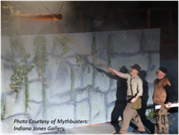 Once again, physicist Rhett Allain brings us an entertaining way to solve a physics problem – in this case involving a system similar to a pendulum. He showcases Mythbusters Raiders of the Lost Ark episode, which tries to duplicate Indy Jones’ classic “whip swing” move. As you might expect, our Mythbusters star was not successful. At some point, the whip lost its grip on the log. Dr. Allain explains the physics of the whip swing system (complete with diagrams and calculations). Then he asks students to extend the learning to solve similar problems themselves.
Once again, physicist Rhett Allain brings us an entertaining way to solve a physics problem – in this case involving a system similar to a pendulum. He showcases Mythbusters Raiders of the Lost Ark episode, which tries to duplicate Indy Jones’ classic “whip swing” move. As you might expect, our Mythbusters star was not successful. At some point, the whip lost its grip on the log. Dr. Allain explains the physics of the whip swing system (complete with diagrams and calculations). Then he asks students to extend the learning to solve similar problems themselves.
- Mr. Rogers IB Physics: Energy Degradation and Power
 When thermal energy is converted to mechanical energy, part of the thermal energy is dissipated into the environment. The energy still exists (energy is always conserved), but is considered degraded because it can no longer do work. Sankey flow diagrams are a great way for students to visualize what happens in energy flow through a heat engine. It's often surprising to students to discover that most of the energy of a heat engine becomes “degraded”. This site, created by a high school teacher, provides great diagrams and charts to help kids understand that dissipated energy is not "lost". *Teachers – This resource meets a specific NGSS Disciplinary Core Idea for the topic of Energy in Chemical Processes: High School PS3.D.i “Although energy cannot be destroyed, it can be converted to less useful forms – for example, to thermal energy in the surrounding environment.”
When thermal energy is converted to mechanical energy, part of the thermal energy is dissipated into the environment. The energy still exists (energy is always conserved), but is considered degraded because it can no longer do work. Sankey flow diagrams are a great way for students to visualize what happens in energy flow through a heat engine. It's often surprising to students to discover that most of the energy of a heat engine becomes “degraded”. This site, created by a high school teacher, provides great diagrams and charts to help kids understand that dissipated energy is not "lost". *Teachers – This resource meets a specific NGSS Disciplinary Core Idea for the topic of Energy in Chemical Processes: High School PS3.D.i “Although energy cannot be destroyed, it can be converted to less useful forms – for example, to thermal energy in the surrounding environment.”
- Triboelectric Nanogenerator Harvests Wasted Power
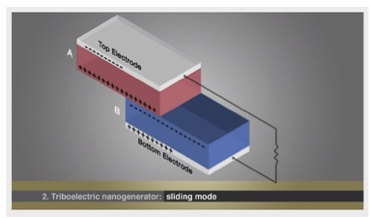 What if there was a way to capture all that wasted mechanical energy that dissipates into the environment? It’s here now, says Zhong Lin Wang, a professor of engineering at Georgia Tech University, who believes the new technology will soon “change the world we live in”. Wang’s team has discovered a way to use triboelectric nano-generators to capture otherwise wasted mechanical energy from sources such as walking, wind blowing, and ocean waves. With one stomp of his foot, Wang can illuminate a thousand LED bulbs. After a humble start, Wang’s research team has increased the power output of their triboelectric generator by a factor of 100,000 to produce as much as 300 watts. “This is just the beginning,” says Wang. (The link includes the video plus an in-depth text article.)
What if there was a way to capture all that wasted mechanical energy that dissipates into the environment? It’s here now, says Zhong Lin Wang, a professor of engineering at Georgia Tech University, who believes the new technology will soon “change the world we live in”. Wang’s team has discovered a way to use triboelectric nano-generators to capture otherwise wasted mechanical energy from sources such as walking, wind blowing, and ocean waves. With one stomp of his foot, Wang can illuminate a thousand LED bulbs. After a humble start, Wang’s research team has increased the power output of their triboelectric generator by a factor of 100,000 to produce as much as 300 watts. “This is just the beginning,” says Wang. (The link includes the video plus an in-depth text article.)
Common Misconceptions:
- Energy is Used Up or Runs Out
Work done on an object by friction and air resistance often serve to remove the mechanical energy from that object. But exactly where does this energy go? Is it used up and no longer present as energy? Raising this question will challenge students to think about non-mechanical forms of energy. When friction does negative work upon an object, the object’s mechanical energy is transformed into thermal energy. Having students rub their hands vigorously against one another will be convincing evidence of how friction acts to turn mechanical energy into thermal energy.
Standards:
A. Next Generation Science Standards (NGSS)
Performance Expectations – Physical Science: Energy
- Middle School MS-PS3-1: Construct and interpret graphical displays of data to describe the relationships of kinetic energy to the mass of an object and to the speed of an object.
- High School HS-PS3-1: Use or create a computational model to calculate the change in the energy of one component in a system when the change in energy of the other component(s) and energy flows in and out of the system are known.
- High School HS-PS3-2: Develop and use models to illustrate that energy at the macroscopic scale can be accounted for as either motions of particles or energy stored in fields.
Disciplinary Core Ideas – Physical Science: Energy – Definitions of Energy
- Middle School MS.PS3.a.iii: Motion energy is properly called kinetic energy; it is proportional to the mass of the moving object and grows with the square of its speed.
- Middle School MS.PS3.a.iv: A system of objects may also contain stored (potential) energy, depending on their relative positions.
- High School HS-PS3.a.ii: Energy is a quantitative property of a system that depends on the motion and interactions of matter and radiation within that system. That there is a single quantity called energy is due to the fact that a system's total energy is conserved, even as, within the system, energy is continually transferred from one object to another and between its various possible forms.
- High School HS-PS3.a.iii: At the macroscopic scale, energy manifests itself in multiple ways, such as in motion, sound, light, and thermal energy.
Disciplinary Core Ideas – Physical Science: Energy – Conservation of Energy/EnergyTransfer
- Middle School MS-PS3.b.i: When the motion energy of an object changes, there is inevitably some other change in energy at the same time.
- Middle School MS-PS3.c.i: When two objects interact, each one exerts a force on the other that can cause energy to be transferred to or from the object.
- High School HS-PS3.b.ii: Energy cannot be created or destroyed, but it can be transported from one place to another and transferred between systems.
- High School HS-PS3.B.iii: Mathematical expressions, which quantify how the stored energy in a system depends on its configuration (e.g. relative positions of charged particles, compression of a spring) and how kinetic energy depends on mass and speed, allow the concept of conservation of energy to be used to predict and describe system behavior.
- High School HS-PS3.B.iv: The availability of energy limits what can occur in any system.
Disciplinary Core Ideas – Physical Science: Energy – Conservation of Energy/EnergyTransfer
- High School HS-PS3.D.i: Although energy cannot be destroyed, it can be converted to less useful forms – for example, to thermal energy in the surrounding environment.
- High School HS-PS3.D.ii: Solar cells are human-made devices that likewise capture the sun’s energy and produce electrical energy.
Crosscutting Concepts
Patterns
- Middle School: Patterns can be used to identify cause and effect relationships.
- Middle School: Graphs, charts, and images can be used to identify patterns in data.
- Middle School: Patterns in rates of change and other numerical relationships can provide information about natural systems.
Cause and Effect
- Middle School: Cause and effect relationships may be used to predict phenomena in natural systems.
- High School: Systems can be designed to cause a desired effect.
- High School: Cause and effect relationships can be suggested and predicted for complex natural systems by examining what is known about smaller-scale mechanisms within the system.
Systems and System Models
- Middle School: Models can be used to represent systems and their interactions, such as inputs, processes and outputs, and energy, matter, and information flows within systems.
- High School: Models (e.g. physical, mathematical, computer models) can be used to simulate systems and interactions – including energy, matter, and information flows – within and between systems at different scales.
Energy and Matter
- Middle School: The transfer of energy can be tracked as energy flows through a designed or natural system.
- Middle School: Within a natural or designed system, the transfer of energy drives the motion and/or cycling of matter.
- High School: Changes of energy and matter in a system can be described in terms of energy and matter flows into, out of, and within that system.
- High School: Energy cannot be created or destroyed – it only moves between one place and another, between objects and/or fields, or between systems.
Science and Engineering Practices
Practice #2: Developing and Using Models
- Middle School: Develop a model to describe unobservable mechanisms.
- High School: Use a model based on evidence to illustrate the relationships between systems or between components of a system.
- High School: Use a model to provide mechanistic accounts of phenomena.
Practice #3: Analyzing and Interpreting Data
- High School: Analyze data using tools, technologies, and/or models (e.g. computational, mathematical) to make valid and reliable scientific claims or determine an optimal design solution.
Practice #5: Constructing Explanations
- High School: Construct and revise an explanation based on valid and reliable evidence obtained from a variety of sources (including students' own investigations, models, theories, simulations, peer review) and the assumption that theories and laws that describe the natural world operate today as they did in the past and will continue to do so in the future.
Practice #8: Using Mathematics and Computational Thinking
- High School: Use mathematical representations of phenomena to describe explanations.
- High School: Use a computational representation of phenomena to describe and/or support claims and/or explanations.
B. Common Core Standards for Mathematics (CC) – Grades 9-12
Standards for Mathematical Practice:
- MP.1 - Make sense of problems and persevere in solving them.
- MP.2 - Reason abstractly and quantitatively
- MP.4 - Model with mathematics
High School Algebra: Creating Equations
- A-CED.4 – Rearrange formulas to highlight a quantity of interest, using the same reasoning as solving equations.
High School Functions: Interpreting Functions
- F-IF.4 - For a function that models a relationship between two quantities, interpret key features of graphs and tables in terms of the quantities, and sketch graphs showing key features given a verbal description of the relationship.
- F-IF.6 - Calculate and interpret the average rate of change of a function over a specified interval. Estimate the rate of change from a graph.
High School Functions: Linear, Quadratic, and Exponential Models
- F-LE.1.b: Recognize situations in which one quantity changes at a constant rate per unit interval relative to another.
- F-LE.1.c: Recognize situations in which a quantity grows or decays by a constant percent rate per unit interval relative to another.